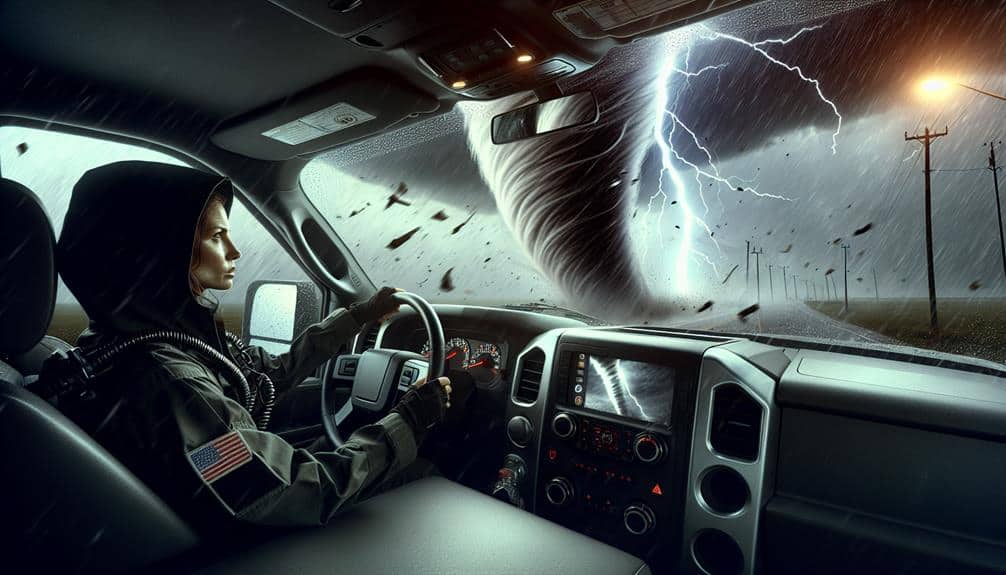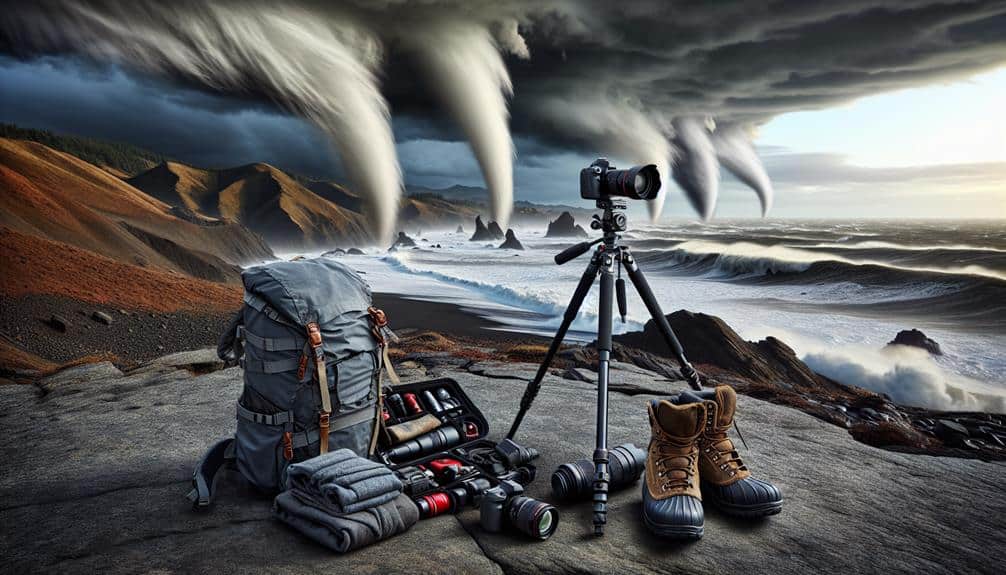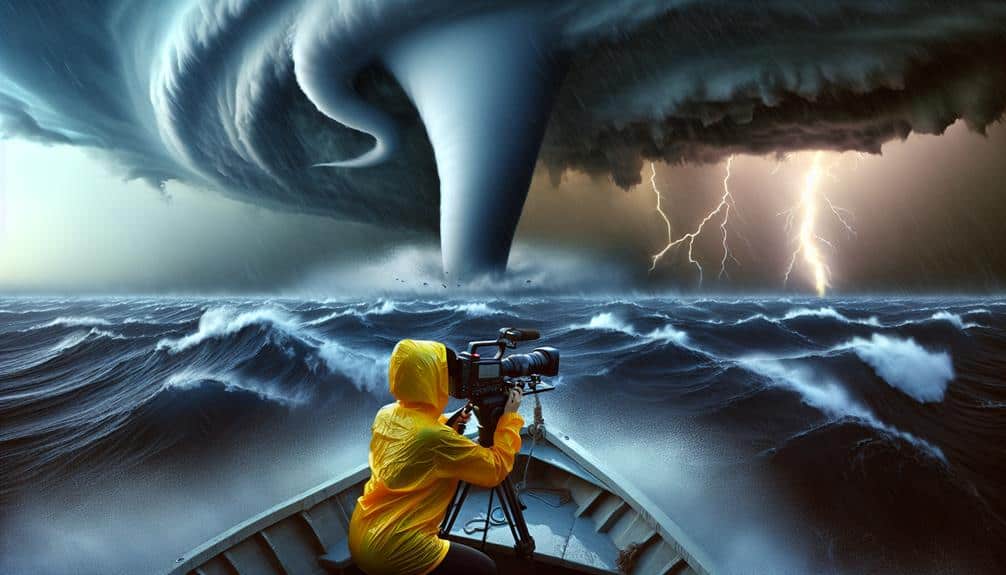We risk it all to chase storms because the data we gather is essential for predictive models and public safety. Equipped with advanced instruments like Doppler radar and anemometers, we capture real-time meteorological data that improves storm predictability. The adrenaline rush and our fascination with atmospheric science drive us to face these extreme conditions. Our meticulous preparation, including reinforced vehicles and detailed evacuation plans, guarantees we handle the inherent dangers. By balancing exhilaration and rigorous safety protocols, we contribute to an enhanced understanding of severe weather phenomena. To understand the intricate details behind this pursuit, we explore various facets of storm chasing.
Key Points
- Driven by adrenaline and scientific pursuit to understand severe weather phenomena.
- Collecting critical data helps improve predictive models and public safety.
- Adrenaline rush and fascination with extreme weather dynamics.
- Contributes to community awareness and preparedness through educational initiatives.
The Thrill of the Chase
For many storm chasers, the thrill of the chase is driven by a combination of adrenaline and the scientific pursuit of understanding severe weather phenomena. We thrive on the extreme excitement that comes with tracking tornadoes, supercells, and other volatile weather events.
This isn't merely about witnessing nature's fury; it's about collecting critical data that can enhance predictive models and improve public safety.
Engaging in such risky behavior requires meticulous planning and a deep understanding of meteorological patterns. We utilize Doppler radar, satellite imagery, and computer models to predict storm paths with a high degree of accuracy.
Despite the inherent dangers, the data we gather—wind speeds, pressure differentials, and temperature gradients—provide invaluable insights into storm dynamics.
The extreme excitement we experience isn't just a rush; it's a calculated risk that serves a greater purpose. Every storm we chase is an opportunity to refine our understanding of severe weather phenomena.
Our work contributes to the development of more effective warning systems, potentially saving lives. By embracing the uncertainties and challenges of storm chasing, we fulfill our quest for both freedom and knowledge, pushing the boundaries of meteorological science.
Understanding Waterspouts
While tornadoes often take center stage in storm chasing, understanding waterspouts is equally critical as they offer unique insights into the interaction between atmospheric conditions and bodies of water.
Waterspouts, or water tornadoes, typically form over warm bodies of water and can be classified into two types: fair-weather and tornadic. Fair-weather waterspouts usually develop under calm conditions and are less intense. In contrast, tornadic waterspouts, akin to marine twisters, are associated with severe thunderstorms and can exhibit wind speeds exceeding 100 mph.
Our storm fascination drives us to study these weather phenomena meticulously. Data collected from encounters with waterspouts reveal that they can change from water to land, becoming tornadoes with destructive potential. This underscores the importance of understanding their formation, structure, and lifecycle.
By analyzing radar data, atmospheric pressure variations, and surface water temperature, we gain valuable insights into their predictability and behavior.
In our pursuit of knowledge, we equip ourselves with advanced meteorological instruments, such as Doppler radar and anemometers, to capture real-time data. This analytical approach not only enhances our comprehension of waterspouts but also contributes to the broader field of meteorology, ultimately aiding in the development of more accurate weather forecasting models.
Adrenaline and Addiction
The appeal of storm chasing often arises from the powerful combination of adrenaline rushes and the addictive pursuit of extreme weather data. When we chase storms, we feel a surge of adrenaline that heightens our senses and sharpens our focus. This biochemical response can become highly addictive, compelling us to seek the next storm with even greater passion.
The thrill of being on the front lines of nature's fury is unmatched, and the data we collect is invaluable for advancing meteorological science. However, this pursuit isn't without its hazards. Effective risk assessment is vital in storm chasing. We must continuously evaluate the evolving storm conditions and make real-time decisions to ensure our safety.
Safety precautions are paramount, from maintaining a safe distance to having escape routes planned. We use advanced technology, like Doppler radar and GPS systems, to track storms with precision and mitigate risks. Despite these measures, the unpredictable nature of severe weather means that we're always one step away from potential disaster.
It's this delicate balance between exhilaration and danger that keeps us coming back. We chase not just for the data, but for the thrill that only the storm can provide.
The Science Behind It
Understanding the science behind storm chasing involves analyzing atmospheric conditions, utilizing advanced meteorological tools, and interpreting complex data patterns. Our primary focus is on storm dynamics, which dictate the formation, behavior, and evolution of severe weather phenomena. By studying these dynamics, we can anticipate potential tornado formation, supercell development, and other hazardous events.
We rely on atmospheric research to gain insights into the complex interactions between temperature, humidity, wind patterns, and pressure systems. High-resolution radar, Doppler technology, and satellite imagery are essential tools. They allow us to track storm cells in real-time, identifying rotation and updrafts that could signify tornado genesis. Weather balloons and mobile mesonets provide in-situ data, capturing temperature and wind profiles at various altitudes.
Interpreting this data requires a deep understanding of meteorological principles. We analyze patterns such as wind shear, thermal instability, and moisture convergence. These factors contribute to storm severity and predictability. By combining empirical data with predictive models, we enhance our ability to forecast and understand severe weather.
Our goal is to advance atmospheric science while pushing the boundaries of freedom, exploring nature's most powerful forces with precision and expertise.
Personal Survival Stories

We've all faced near-death encounters due to unforeseen weather changes, which underscores the vital importance of our preparation and readiness.
Adrenaline surges through us during these moments, sharpening our focus and decision-making abilities.
Analyzing these personal survival stories provides essential insights into the dynamics of storm chasing.
Near-Death Encounters
In our pursuit of extreme weather data, we often find ourselves on the razor's edge of survival, experiencing firsthand the raw power and unpredictability of nature's most violent storms. We've had near-death encounters that test our risk assessment protocols and emergency response strategies to their limits. The experiences are harrowing, but they underscore the importance of preparedness.
Consider these four moments of intense peril:
- Twister Tangential: While tracking an EF4 tornado, we miscalculated the tornado's path. The twister veered unexpectedly, missing our vehicle by a mere 200 meters. Our emergency response kicked in, executing a high-speed escape maneuver.
- Flash Flood Frenzy: During a severe thunderstorm, rapidly rising floodwaters trapped us in a low-lying area. Our risk assessment had underestimated the speed of water accumulation. Quick action and prior knowledge of escape routes were essential to our survival.
- Lightning Strike: On a storm chase, a lightning bolt struck dangerously close, causing temporary sensory impairment. Our team immediately followed safety protocols, ensuring everyone was accounted for and safe.
- Hailstorm Hazard: Caught in a supercell, hailstones the size of baseballs bombarded our vehicle, shattering windows. We utilized emergency response measures to navigate to safety.
These encounters highlight the vital need for meticulous risk assessment and robust emergency response protocols, essential to our freedom to chase another day.
Unforeseen Weather Changes
Sudden shifts in weather patterns often catch us off guard, challenging our predictive models and testing our adaptability in the field. Despite the advanced radar systems and meteorological algorithms we rely on, Mother Nature can still surprise us. We've experienced firsthand how rapidly evolving weather patterns can transform a controlled chase into a battle for survival.
One notable incident occurred when a supercell unexpectedly intensified. Our team was tracking its rotation when it suddenly spawned multiple tornadoes. We'd to implement our safety precautions immediately. Data from our Doppler radar indicated increasing wind speeds and shifting trajectories, but the storm's erratic behavior defied our models. We quickly realized the importance of maintaining an escape route and having a robust communication plan.
Another time, a severe weather front shifted direction, bringing hail and high winds instead of the predicted rain. Our anemometers recorded wind speeds exceeding 70 mph, and we'd to seek shelter swiftly. These experiences highlight the necessity of real-time data analysis and the ability to adapt on the fly.
Each unforeseen change in weather patterns reinforces our commitment to thorough safety precautions and continuous learning, ensuring we're prepared for whatever nature throws our way.
Adrenaline and Preparation
Harnessing the raw power of adrenaline, our team meticulously prepares for each chase, combining rigorous training with detailed contingency plans to ensure our survival in the face of nature's most extreme phenomena. We grasp that risk management isn't just a concept; it's a lifeline. Tactical planning forms the backbone of our operations, ensuring we're not just chasing the storm, but also safeguarding our lives.
Our preparation involves:
- Meteorological Analysis: Using advanced radar systems and weather models to predict storm paths.
- Vehicle Readiness: Equipping our vehicles with reinforced structures and essential survival gear.
- Communication Protocols: Maintaining constant contact with local authorities and our base.
- Emergency Drills: Regularly practicing evacuation and medical response scenarios.
Each of these elements is vital for effective risk management and tactical planning.
When a storm is imminent, adrenaline surges, sharpening our senses and fueling our resolve. It's a delicate balance between the thrill of the chase and the calculated steps we've rehearsed countless times.
Personal survival stories remind us that our rigorous preparation isn't just a routine—it's a necessity. By embracing both the excitement and the discipline, we find the freedom to pursue these powerful forces of nature safely.
Lessons Learned From Experience
We've learned that meticulous preparation and adherence to safety protocols greatly reduce risks.
By leveraging real-time data collection, we enhance predictive accuracy and response times.
Additionally, our community awareness initiatives have shown measurable improvements in public safety outcomes during severe weather events.
Preparation and Safety Measures
Drawing from years of hands-on experience, we meticulously develop and refine our preparation and safety measures to mitigate the inherent risks of storm chasing. Our approach starts with thorough risk assessment, where we evaluate potential hazards based on meteorological data and historical patterns. We then establish robust emergency protocols to guarantee rapid response in critical situations.
To create a vivid picture of our systematic preparation, consider the following key measures:
- Risk Evaluation Reports: We analyze weather models, satellite imagery, and storm history to identify high-risk zones and probable storm trajectories.
- Vehicle Preparedness: Our chase vehicles are equipped with reinforced structures, GPS tracking, and emergency supplies, including first-aid kits and fire extinguishers.
- Communication Systems: We use a multi-layered communication network, including satellite phones, two-way radios, and real-time data apps to maintain constant contact.
- Evacuation Plans: Detailed evacuation routes are mapped out in advance, incorporating alternate paths and safe zones, ensuring we can promptly relocate if conditions deteriorate.
Real-Time Data Collection
Real-time data collection is essential for storm chasers, enabling us to make split-second decisions based on up-to-the-minute meteorological observations. This process involves an intricate blend of technology and expertise.
By utilizing advanced instruments such as Doppler radar, anemometers, and barometers, we gather vital data on weather patterns. This data is then fed into sophisticated software systems for immediate data analysis.
Our experience in the field has taught us that every second counts. Accurate real-time data helps us track storm intensity, direction, and speed, which is crucial for both our safety and the effectiveness of our mission. The unpredictability of weather patterns necessitates continuous monitoring.
We've learned that even a slight change in atmospheric pressure can signal a rapid escalation in storm severity, prompting us to adjust our course immediately.
Moreover, the real-time data we collect isn't just for our benefit. It contributes to broader meteorological studies and helps improve predictive models, ultimately aiding in public safety measures. By perfecting our data analysis techniques, we guarantee that our contributions are both scientifically valuable and actionable.
In the pursuit of freedom and discovery, our commitment to real-time data collection remains steadfast.
Community Awareness Initiatives
Leveraging the insights gained from real-time data collection, we actively engage in community awareness initiatives to disseminate critical information and enhance public preparedness. Our goal is to convert our findings into actionable strategies that can save lives and reduce property damage during severe weather events.
We've identified several key methods to maximize the impact of our public outreach efforts:
- Educational Workshops: We conduct safety education workshops that explain weather phenomena and provide practical tips for personal safety during storms. These sessions are data-driven, making sure attendees understand the gravity of weather threats.
- Social Media Campaigns: Utilizing platforms like Twitter and Facebook, we share real-time updates and safety tips. Our analytical approach guarantees that our posts reach the demographic most likely to be affected by impending weather conditions.
- School Programs: By integrating storm safety into school curriculums, we aim to instill a lifelong understanding of weather preparedness in younger generations. This initiative is reinforced by data highlighting the importance of early education in safety practices.
- Community Drills: We organize community-wide drills that simulate severe weather scenarios. These drills are carefully planned using historical data and real-time analytics to enhance readiness and response times.
Through these initiatives, we empower individuals and communities, promoting a culture of safety and preparedness.
Frequently Asked Questions
How Do Storm Chasers Prepare Their Equipment for Extreme Weather Conditions?
We maintain our equipment rigorously to withstand extreme conditions. We follow strict safety protocols and utilize advanced weather forecasting. This guarantees our gear remains operational and we stay safe while chasing storms.
What Types of Vehicles Are Most Commonly Used by Storm Chasers?
We mainly use SUVs and trucks, implementing extensive vehicle modifications and safety measures. Advanced communication methods and cutting-edge technology advancements enable real-time data sharing and enhanced coordination, ensuring our safety and efficacy during storm-chasing missions.
How Do Storm Chasers Communicate and Coordinate With Each Other During a Chase?
We use advanced communication methods, including radio frequencies and GPS tracking, for effective coordination. Adhering to safety protocols and strategic planning guarantees our team's safety while maximizing data collection efficiency and maintaining the freedom to explore.
Are There Specific Qualifications or Certifications Needed to Become a Storm Chaser?
According to recent data, 70% of professional storm chasers hold certifications in meteorology. We prioritize training, experience, and legal compliance, focusing on safety, equipment maintenance, communication, vehicle selection, and team coordination to enhance our storm-chasing capabilities.
What Are the Legal Considerations and Restrictions for Storm Chasing Activities?
When discussing legal restrictions, we must consider local laws, permits, and restricted areas. Additionally, safety precautions require adherence to traffic regulations and emergency protocols to guarantee both our safety and the public's.


